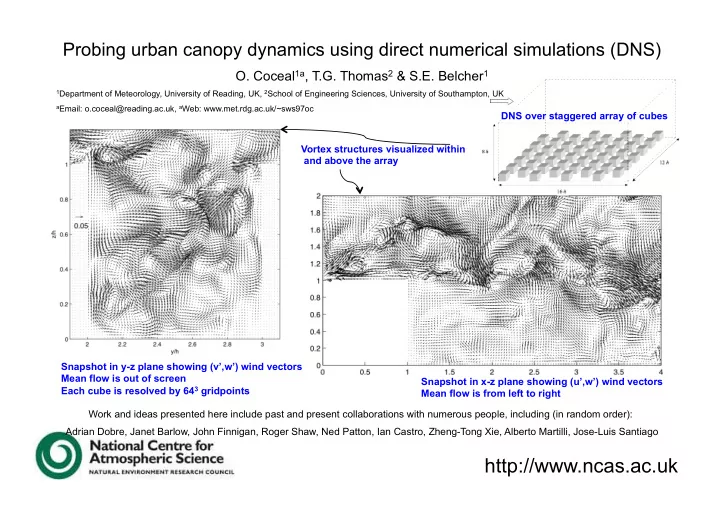

Probing urban canopy dynamics using direct numerical simulations (DNS) O. Coceal 1a , T.G. Thomas 2 & S.E. Belcher 1 1 Department of Meteorology, University of Reading, UK, 2 School of Engineering Sciences, University of Southampton, UK a Email: o.coceal@reading.ac.uk, a Web: www.met.rdg.ac.uk/~sws97oc DNS over staggered array of cubes Vortex structures visualized within and above the array Snapshot in y-z plane showing (v’,w’) wind vectors Mean flow is out of screen Snapshot in x-z plane showing (u’,w’) wind vectors Each cube is resolved by 64 3 gridpoints Mean flow is from left to right Work and ideas presented here include past and present collaborations with numerous people, including (in random order): Adrian Dobre, Janet Barlow, John Finnigan, Roger Shaw, Ned Patton, Ian Castro, Zheng-Tong Xie, Alberto Martilli, Jose-Luis Santiago http://www.ncas.ac.uk
Questions Do we have a simple picture of urban canopy turbulence? Taking inspiration from, but not being biased by, vegetation canopy ideas How do flow features and statistics depend on urban canopy parameters? Indeed, what ARE those parameters? How do we parameterize drag and turbulence in urban areas? Or perhaps, how we should NOT parameterize them This talk will bring together just a few results from my work that are relevant to those questions, rather than describe any individual piece of work in detail. Results are mainly from direct numerical simulations (DNS) and large eddy simulations (LES).
Some results relevant to the structure and dynamics of urban turbulence
Two-point correlations and quadrant analysis Ruu for zero time delay Exuberance
Eddy structure and a conceptual model Instantaneous realisations Conditional eddy EOF reconstruction Coceal, Dobre, Thomas & Belcher, JFM 2007 Conceptual model Coceal, Dobre & Thomas, IJC 2007
Flow dependence on urban morphological parameters and wind conditions
Dependence of flow statistics on building layout Different building layouts, same packing density of λ = 0.25 (Detailed explanation of this plot in Coceal, Thomas, Castro & Belcher, BLM 2006) • Large differences between staggered and aligned/square configurations • Turbulence intensities, shear stress and mean velocity all lower in staggered array • Dispersive stress profiles are qualitatively different due to very different mean flow structure • Sectional drag coefficient in the staggered array is an order of magnitude larger • Because of these large differences, different degrees of staggering need to be explored
Effect of variable building heights Spatially averaged velocities Dispersive stress Xie, Coceal and Castro, BLM 2008 • Spatial averages are surprisingly similar to regular array below mean building height • But tall buildings have large effect • Eg 22% of drag exerted by tallest building • Large amount of TKE due to tallest building • Spatially averaged TKE profile peaks at the height of the tallest building (not the mean building height) TKE countours at several heights Drag profiles due to individual buildings TKE profile
Influence of other parameters Effect of wind direction Four wind directions investigated over a square array (see plot) Also discussed in detail by Jean Claus this afternoon u-v wind-vectors and w contours for 26.6° flow Spatially-averaged profiles of streamwise and lateral mean velocity in street-aligned and wind-aligned coord. systems Effect of packing density Investigated e.g. by Kanda et al (2004), Santiago et al. (2008), Kono et al. (2008), Leonardi & Castro (2009) No time to review here Effect of building shape, degree of staggering, height variability Currently under study and results will be reported at ICUC7 in Japan (July 2009)
Some thoughts on the parameterization of turbulence and drag
Pressure drag The problem with the drag coefficient approach Staggered vs aligned arrays Cd(z) and cdmod(z) for staggered arrays at different packing densities • cd(z) blows up near the ground • It is very sensitive to building layout • Parameterize the drag force instead? Normalized drag profiles for random array
Turbulent stress Mixing length profile for regular stagerred array Mixing length profile for random array • Effective mixing length computed from DNS data for staggered array and LES data for random height staggered array • Mixing length is far from constant within urban canopy, unlike deep vegetation canopies • Blocking by strong shear layers • Subsequently, Kono et al found similar behaviour at a range of packing densities for both staggered and aligned arrays
Dispersive stress Dispersive stresses in random array Xie, Coceal and Castro, BLM 2008 • Dispersive stresses and their vertical gradients are not small within the urban canopy • But how do we parameterize them? Dispersive stresses and their gradients in regular arrays Coceal, Thomas & Belcher, AG 2008
More Questions Can we obtain a simple picture of urban canopy turbulence? Is there a canonical ‘urban canopy’ flow? What are the dominant ‘urban canopy’ processes? How do they depend on underlying canopy parameters? What are these parameters? How can we apply knowledge at street scales to modelling in larger scale models? There is a growing wealth of results and data at street scales from experiments and modelling But this collective wisdom is not filtering through to the models that need them Perhaps more/wider collaborations are needed between those who generate data and basic knowledge and those who build predictive models What types of parameterizations are needed in applications such as NWP and dispersion? What is needed in current implementations? Can we do better? Specific issues: How do we parameterize the dispersive stress?
Recommend
More recommend